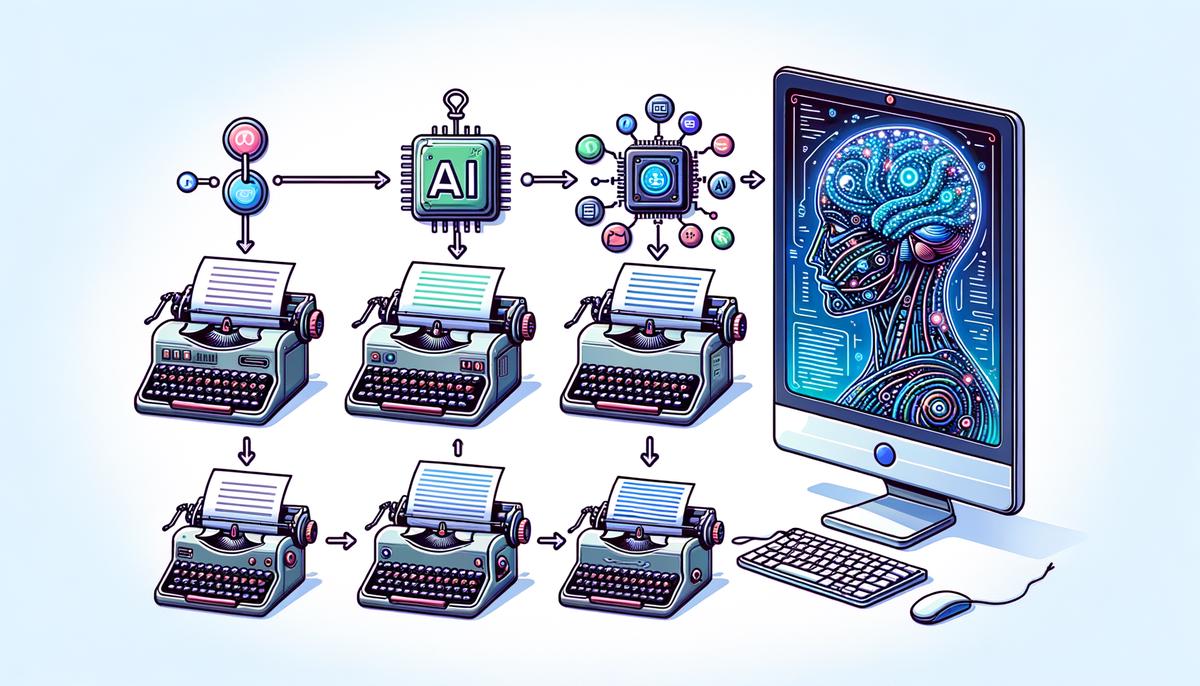AI writing assistants have transformed the landscape of content creation, moving from simple spell checkers to sophisticated tools capable of drafting entire pieces. This evolution reflects the melding of advanced technologies with the art of writing, offering new possibilities and challenges that impact both the writer and the reader. As we explore this progression, we confront the reality of how deeply technology can influence not only the way we write but also how we think about writing itself.
The Evolution of AI Writing Assistants
AI Writing Assistants: An Evolutionary Journey
The transformation of AI writing assistants over the years reads like a tale of rapid technological evolution, breathing life into the very essence of content generation and editing. Initially, these digital helpers were limited to basic spell checks and grammar corrections, but their capabilities have expanded immensely, reshaping our approach to writing.
In the early stages, AI writing tools like Microsoft Word’s spellchecker served as the modest beginnings of what would become a dynamic field. They offered fundamental assistance, focusing on correcting typos and basic grammar errors. However, as technology advanced, so did these assistants.
The introduction of more complex AI systems marked a significant turning point. Tools such as Grammarly and Hemingway Editor emerged, equipped not only to fix simple mistakes but also to analyze sentence structure, tone, and readability. Their advanced algorithms allowed for suggestions that could make writing clearer, more engaging, and tailored to the intended audience.
The real game-changer came with generative AI technologies, such as OpenAI’s GPT series. Starting with GPT-2 and evolving into more sophisticated versions like GPT-3, these tools have the ability to produce entire articles, creative stories, and even technical reports with minimal input from a human writer. Their capacity to understand and generate human-like text has revolutionized content creation, making it possible to draft extensive pieces within minutes.
Moreover, the integration of AI writing assistants into everyday applications has made them more accessible. For example, Google Docs now includes features that suggest entire sentences, enabling faster and more efficient writing. These advancements signify a notable shift from merely correcting mistakes to proactively enhancing the writing process.
AI writing assistants have also become increasingly customized. Depending on the user’s needs, these tools can now adapt to different writing styles and preferences. Whether for academic papers, business reports, or creative storytelling, there’s an AI assistant tailored for the task. This level of personalization ensures that the final output aligns closely with the user’s intent, tone, and style preference.
As we stand on the cusp of further advancements, the potential for AI in writing continues to unfold. With each iteration, these assistants become more ingrained in the fabric of content creation, promising even more innovative and efficient ways to help humans communicate their ideas effectively. The evolution of AI writing tools underscores a journey from simple corrective algorithms to complex, creative partners in the writing process, marking a new era of digital assistance in content creation.

How AI Writing Assistants Work
Building on the transformative influences AI writing assistants have had on the digital landscape, let’s delve into the intricate technologies that power these innovative tools. Central to the operation of AI writing assistants is a technology known as Natural Language Processing (NLP). This technology allows computers to understand, interpret, and generate human text in a way that is both comprehensive and contextually relevant. NLP bridges the gap between human communication and digital understanding, enabling machines to process and analyze large amounts of natural language data.
At the heart of most advanced AI writing assistants, including the likes of OpenAI’s GPT-3, is machine learning, a subset of artificial intelligence. Machine learning algorithms use vast datasets to learn from patterns and structures in text, which then allows these tools to predict and generate content that aligns closely with human writing. The sophistication of these models, particularly in deep learning architectures like neural networks, has significantly improved the fluency and coherency of generated content. Neural networks, with their multi-layered structure, emulate the human brain’s own network of neurons, providing the foundation for the generation of remarkably human-like text.
Another pivotal technology is sentiment analysis, enabling AI writing assistants to gauge the tone and emotion behind the written word. Whether crafting marketing copy or composing an email, these tools can adjust the tone to suit the intended audience or purpose, adding an invaluable layer of customization. Sentiment analysis works by evaluating the words and phrases within a text to classify the underlying sentiment as positive, negative, or neutral.
Entity recognition technology further enhances the capabilities of AI writing assistants. This involves identifying and categorizing key information pieces in the text, such as names, locations, and dates. By understanding the context and relevance of different entities within the content, AI tools can ensure accuracy and relevancy in content creation.
Lastly, the integration of APIs (Application Programming Interfaces) has expanded the utility and accessibility of AI writing assistants. APIs allow these advanced tools to be seamlessly incorporated into a vast array of software applications and online platforms. Whether you’re using a word processor, content management system, or email platform, APIs enable the direct use of AI writing assistants within these environments, making high-quality writing assistance more accessible than ever before.
Through the combined power of these technologies, AI writing assistants are revolutionizing the way we create, edit, and refine content. By understanding the complex mechanics behind these tools, we gain a greater appreciation for their role in enhancing communication and creativity in the digital age.

Benefits and Limitations of AI Writing Assistants
Advancing from its foundation, the use of AI writing assistants carries a blend of significant benefits alongside some notable limitations. Delving deeper, let’s explore how these tools reshape the landscape of writing, editing, and overall content generation, while also acknowledging the hurdles and challenges they present.
One of the key benefits of employing AI writing assistants is the remarkable efficiency they offer. These tools can generate drafts, suggest improvements, and even predict next sentences at an incredible speed. This capability drastically reduces the time writers spend on initial drafts and revisions, allowing for a quicker turnaround on projects. Imagine being tasked with generating a comprehensive report on a tight deadline; an AI writing assistant can streamline this process, enabling you to meet or even beat that deadline.
Moreover, AI writing tools are invaluable for improving the quality of writing. They can detect grammatical errors, suggest more apt vocabulary, and even align writing with specific tone or style guidelines. For businesses, this means communications, whether external or internal, are clearer, error-free, and professional. For individual writers, it elevates the quality of their work, potentially increasing their credibility and audience engagement.
The accessibility and support for writers for whom English is a second language constitute another plus. These technologies can act as on-the-go tutors, helping them understand complex grammatical rules and enhancing their writing skills. This democratizes high-quality writing, making it more accessible to a global audience.
Despite these advantages, AI writing assistants are not without their limitations. One significant drawback is the potential to diminish creativity and originality in writing. As these tools often suggest commonly accepted phrases or sentence structures, there’s a risk that content may become homogenized, losing the unique voice or innovative ideas of the writer. This is particularly concerning in creative writing or content that requires a strong personal or brand identity.
Another limitation is the current inability of AI writing assistants to fully understand context or the nuances of human emotions. While strides have been made, these technologies can sometimes suggest edits or content that might be technically correct but lack the subtlety or empathy a human writer would naturally incorporate. This can lead to misunderstandings or misinterpretations, especially in sensitive topics or narratives.
Lastly, reliance on AI tools for writing might lead to a diminishment in writing skills over time. If writers lean too heavily on these assistants, there’s a risk they may not develop or retain crucial writing, editing, and critical thinking skills. This reliance could create a gap, particularly evident when the technology is unavailable, and one has to rely on their proficiency.
In conclusion, AI writing assistants have transformed the writing landscape, offering remarkable efficiencies, enhancing writing quality, and making polished writing more accessible. However, it’s essential to navigate their use carefully, acknowledging the limitations and ensuring they complement rather than supplant the invaluable human touch in writing. Balancing the innovative prowess of AI with the irreplaceable creativity and insight of human writers will define the next chapter in the evolution of writing.

The Future of AI Writing Assistants
Moving forward, the trajectory for AI writing assistants seems not just promising but revolutionary. As we peek into the future, several emerging trends and anticipated advancements paint an exciting picture. A notable shift is the leap towards even more personalized and intuitive AI-driven writing experiences. The next generation of AI writing tools is expected to offer unprecedented customization, adapting not just to stylistic preferences but also to users’ unique voices and tones. This evolution would transform these tools from mere assistants to collaborative partners in the creation process.
The realm of AI writing is also set to benefit from advancements in Artificial Intelligence and Machine Learning technologies. With the continuous improvement in these foundational technologies, AI writing assistants will become more adept at understanding context and nuances in text. This will address one of the most significant current limitations: the inability to fully grasp the subtleties of human communication, including humor, sarcasm, and complex emotions. As a result, we can anticipate tools that can generate content that feels more natural, engaging, and resonant with the intended audience.
On the horizon is the potential integration of AI writing assistants with other forms of AI, such as virtual reality (VR) and augmented reality (AR), offering immersive storytelling and content creation experiences. Imagine donning a VR headset and narrating a story, while an AI assistant not only writes it down but also suggests plot enhancements, character developments, and even virtual environments where your story can unfold. Such integrations could redefine content creation, making it more accessible and interactive.
Another area ripe for innovation is the application of AI writing tools in education and academic research. With the ability to sift through vast amounts of data, these tools could assist in composing research papers, synthesizing information from multiple sources into coherent narratives, and even suggesting areas for further study. However, this raises important considerations about authorship and intellectual property, necessitating a thoughtful approach to integrating AI into academic endeavors.
Ethical considerations and the potential for misuse of AI writing technologies remain paramount concerns. As these tools become more powerful, the line between human-generated and AI-generated content may blur, raising questions about authenticity, misinformation, and the potential for AI-generated propaganda. Ensuring transparency about the use of AI in content creation and establishing guidelines for ethical use will be crucial in addressing these challenges.
In conclusion, the future of AI writing assistants is laden with opportunities to revolutionize how we create and interact with text. From enhanced personalization to immersive content creation and ethical use, the journey ahead is as thrilling as it is fraught with challenges. As technology continues to evolve, so too will our relationship with writing, storytelling, and communication.

The advancements in AI writing assistants continue to push the boundaries of what is possible in content creation, reshaping our expectations and methods in the process. With each step forward, these tools do not just serve as aids but as catalysts for a new era in writing, blending creativity with technology. As we look to the future, it’s clear that the collaboration between human insight and artificial intelligence will redefine our approach to communication, storytelling, and expression in profound ways.






